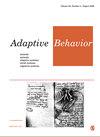海马体构建的分层表征如何用于空间导航的模型
IF 1.3
4区 计算机科学
Q4 COMPUTER SCIENCE, ARTIFICIAL INTELLIGENCE
引用次数: 0
摘要
动物能够以惊人的灵活性和效率在复杂的环境中穿梭:它们在大范围内觅食,迅速学习有回报的行为,并在必要时改变计划。海马体(HPC)是一种参与导航、学习和记忆的大脑结构,它的神经机制支持了动物的这种能力。海马体中的神经元活动提供了空间的分层表征,代表了多种尺度的环境。此外,据观察,当 HPC 中的记忆巩固过程失活时,动物仍能在熟悉的环境中进行规划和导航,但在新环境中就不行了。诸如此类的发现提出了三个有用的原则:空间学习是分层的;学习分层的世界模型具有内在价值;行动规划是与学习分离的下游过程。在这里,我们通过计算演示了一个代理如何利用离线重放环境中的轨迹来学习环境的分层模型,并通过经验表明,这可以在强化学习环境中实现高效的计算规划,以达到任意目标。利用计算模型模拟海马受损情况,可以重现在海马失活的啮齿类动物身上观察到的导航行为。本文介绍的方法可能有助于澄清对一些啮齿类动物空间导航研究的不同解释,并对未来的机器智能和生物智能研究产生一些影响。本文章由计算机程序翻译,如有差异,请以英文原文为准。
A model of how hierarchical representations constructed in the hippocampus are used to navigate through space
Animals can navigate through complex environments with amazing flexibility and efficiency: they forage over large areas, quickly learning rewarding behavior and changing their plans when necessary. Some insights into the neural mechanisms supporting this ability can be found in the hippocampus (HPC)—a brain structure involved in navigation, learning, and memory. Neuronal activity in the HPC provides a hierarchical representation of space, representing an environment at multiple scales. In addition, it has been observed that when memory-consolidation processes in the HPC are inactivated, animals can still plan and navigate in a familiar environment but not in new environments. Findings like these suggest three useful principles: spatial learning is hierarchical, learning a hierarchical world-model is intrinsically valuable, and action planning occurs as a downstream process separate from learning. Here, we demonstrate computationally how an agent could learn hierarchical models of an environment using off-line replay of trajectories through that environment and show empirically that this allows computationally efficient planning to reach arbitrary goals within a reinforcement learning setting. Using the computational model to simulate hippocampal damage reproduces navigation behaviors observed in rodents with hippocampal inactivation. The approach presented here might help to clarify different interpretations of some spatial navigation studies in rodents and present some implications for future studies of both machine and biological intelligence.
求助全文
通过发布文献求助,成功后即可免费获取论文全文。
去求助
来源期刊

Adaptive Behavior
工程技术-计算机:人工智能
CiteScore
4.30
自引率
18.80%
发文量
34
审稿时长
>12 weeks
期刊介绍:
_Adaptive Behavior_ publishes articles on adaptive behaviour in living organisms and autonomous artificial systems. The official journal of the _International Society of Adaptive Behavior_, _Adaptive Behavior_, addresses topics such as perception and motor control, embodied cognition, learning and evolution, neural mechanisms, artificial intelligence, behavioral sequences, motivation and emotion, characterization of environments, decision making, collective and social behavior, navigation, foraging, communication and signalling.
Print ISSN: 1059-7123
 求助内容:
求助内容: 应助结果提醒方式:
应助结果提醒方式:


